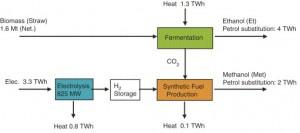This paper analyses the mutual benefits of integrating strategies for future energy and transport CO2emissions control. The paper illustrates and quantifies the mutual benefits of integrating the transport and the energy sector in the case of Denmark. Today this issue is very relevant in Denmark due to the high share of fluctuating renewable energy produced in the country. In the future, such issue will apply to other countries who plan to use a high share of renewable energy. In short, the energy sector can help the transport sector to replace oil by renewable energy and combined heat and power production (CHP), while the transport sector can assist the energy system in integrating a higher degree of intermittent energy and CHP. Two scenarios for partial conversion of the transport fleet have been considered. One is battery cars combined with hydrogen fuel cell cars, while the other is the use of biofuel (ethanol) and synthetic fuel (methanol) for internal combustion cars. An increase in the fraction of electricity delivered by fluctuating sources like wind power will lead to excess electricity production and the two aforementioned scenarios have a substantial effect on the decrease of the excess production.




